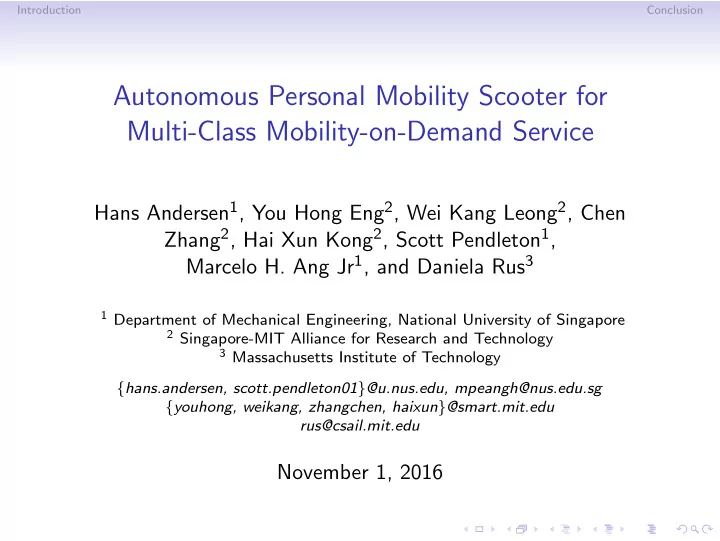

Introduction Conclusion Autonomous Personal Mobility Scooter for Multi-Class Mobility-on-Demand Service Hans Andersen 1 , You Hong Eng 2 , Wei Kang Leong 2 , Chen Zhang 2 , Hai Xun Kong 2 , Scott Pendleton 1 , Marcelo H. Ang Jr 1 , and Daniela Rus 3 1 Department of Mechanical Engineering, National University of Singapore 2 Singapore-MIT Alliance for Research and Technology 3 Massachusetts Institute of Technology { hans.andersen, scott.pendleton01 } @u.nus.edu, mpeangh@nus.edu.sg { youhong, weikang, zhangchen, haixun } @smart.mit.edu rus@csail.mit.edu November 1, 2016
Introduction Conclusion Outline • Introduction • System Overview • Experimental Results and Discussions • Conclusion
Introduction Conclusion Multi-Class Mobility Figure: SMART’s Autonomous Vehicle Fleet
Introduction Conclusion Shared Core Competencies • Mapping and localization in 3D environment with syn- thetic 2D LIDAR • Dynamic replanning for online obstacle avoidance • Moving obstacles detection and tracking • Intuitive web-based booking system
Introduction Conclusion Main Contributions 1. Design and development of a new autonomous personal mobility scooter capable for mobility on demand : Compact Size, Maneouvearbilty, Efficient Operations in Crowded Environment 2. Adapting our mapping, localization, perception, and planning capabilities to the scooter platform : Similar sensors and software packages to what has been implemented before, maximizing code re-usability and demonstrating the flexibility of our software architecture. 3. Extensive experiments and user surveys : Showcased during MIT’s open house, 99 trips, totalling 7.23 km travelled in autonomous mode.
Introduction Conclusion Hardware Overview Self-Driving Mobility Scooter IMU Emergency Button LIDAR Computer (Mapping & Localization) Network Switch Monitor Batteries Control Panel Power Interface Circuit Distribution LIDAR Overcurrent (Obstacle Protection Detection) Wheel Encoders Steering Motor Figure: Hardware overview, highlighting primary retrofit additions to a personal mobility scooter in order to enable autonomous capability
Introduction Conclusion Specifications Table: Personal Mobility Scooter Specification Dimensions (L x W x H) 930 x 485 x 2100 mm Empty Weight 56 Kg Maximum Payload 85 Kg Maximum Speed 8.0 Km/h Maximum Safe Slope 6 Degrees Range 20 Km
Introduction Conclusion Hardware Overview Main Computer (Ubuntu 14.04 + ROS Indigo) Ethernet Microcontroller & Scooter Motor USB Hub Switch Interface Board Controler Top Remote IMU E-Stop LIDAR Bottom Input Steering Scooter Motor LIDAR Devices Servo Manual/ Rotary Encoders Auto/ Pause Buttons Webcam DC-DC Converters, Overcurrent Protection and Power Distribution Signal Power Stock Li-Pol Battery Auxiliary Lead Acid Batteries 2 x 12V, 22Ah 24V, 11.5 Ah Figure: Scooter electrical system connection diagram
Introduction Conclusion Hardware Overview Figure: CAD drawings of the scooter’s original motor and wheels assembly(left), and with rotary encoders mounted(right)
Introduction Conclusion Hardware Overview Figure: CAD drawings of the scooter’s original steering column assembly(left), and the repositioned steering column with steering servo mounted (right)
Introduction Conclusion Software Overview Figure: System Architecture
Introduction Conclusion Software Overview Figure: Online booking system for National University of Singapore’s University Town
Introduction Conclusion Software Overview Figure: Dynamic Virtual Bumper
Introduction Conclusion Software Overview Figure: Perception Visualization
Introduction Conclusion Experiments Figure: National University of Singapore University Town
Introduction Conclusion Experiments Figure: MIT’s Infinite Corridor
Introduction Conclusion Experimental Results
Introduction Conclusion Survey Results Table: Public Trial Survey Results, with 99 Users Surveyed How much do you know about autonomous vehicles? 2.2/5.0 How safe do you think autonomous vehicles are? 3.5/5.0 How would you rate your experience in terms of SAFETY? 4.6/5.0 How would you rate your experience in terms of COMFORT? 4.5/5.0 Would you ride on this autonomous scooter again? 96% Yes
Introduction Conclusion Video https://youtu.be/_6otshNzqqo
Introduction Conclusion Thank You
Recommend
More recommend